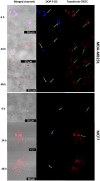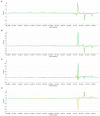Lipid-Based Nanovesicles for Simultaneous Intracellular Delivery of Hydrophobic, Hydrophilic, and Amphiphilic Species
- PMID: 32719782
- PMCID: PMC7350901
- DOI: 10.3389/fbioe.2020.00690
Lipid-Based Nanovesicles for Simultaneous Intracellular Delivery of Hydrophobic, Hydrophilic, and Amphiphilic Species
Abstract
Lipid nanovesicles (NVs) are the first nanoformulation that entered the clinical use in oncology for the treatment of solid tumors. They are indeed versatile systems which can be loaded with either hydrophobic or hydrophilic molecules, for both imaging and drug delivery, and with high biocompatibility, and limited immunogenicity. In the present work, NVs with a lipid composition resembling that of natural vesicles were prepared using the ultrasonication method. The NVs were successfully loaded with fluorophores molecules (DOP-F-DS and a fluorescent protein), inorganic nanoparticles (quantum dots and magnetic nanoparticles), and anti-cancer drugs (SN-38 and doxorubicin). The encapsulation of such different molecules showed the versatility of the developed systems. The size of the vesicles varied from 100 up to 300 nm depending on the type of loaded species, which were accommodated either into the lipid bilayer or into the aqueous core according to their hydrophobic or hydrophilic nature. Viability assays were performed on cellular models of breast cancer (MCF-7 and MDA-MB-231). Results showed that NVs with encapsulated both drugs simultaneously led to a significant reduction of the cellular activity (up to 22%) compared to the free drugs or to the NVs encapsulated with only one drug. Lipidomic analysis suggested that the mechanism of action of the drugs is the same, whether they are free or encapsulated, but administration of the drugs by means of nanovesicles is more efficient in inducing cellular damage, likely because of a quicker internalization and a sustained release. This study confirms the versatility and the potential of lipid NVs for cancer treatment, as well as the validity of the ultrasound preparation method for their preparation.
Keywords: SN-38; breast cancer; doxorubicin; lipidomic analysis; nanoparticle; nanovesicle.
Copyright © 2020 Zacheo, Bizzarro, Blasi, Piccirillo, Cardone, Gigli, Ragusa and Quarta.
Figures









Similar articles
-
Sparstolonin B potentiates the antitumor activity of nanovesicle-loaded drugs by suppressing the phagocytosis of macrophages in vivo.J Nanobiotechnology. 2024 Dec 18;22(1):759. doi: 10.1186/s12951-024-03001-6. J Nanobiotechnology. 2024. PMID: 39696573 Free PMC article.
-
Dual stimuli polysaccharide nanovesicles for conjugated and physically loaded doxorubicin delivery in breast cancer cells.Nanoscale. 2015 Apr 21;7(15):6636-52. doi: 10.1039/c5nr00799b. Nanoscale. 2015. PMID: 25797322
-
In situ DOX-calcium phosphate mineralized CPT-amphiphilic gelatin nanoparticle for intracellular controlled sequential release of multiple drugs.Acta Biomater. 2015 Mar;15:191-9. doi: 10.1016/j.actbio.2014.12.013. Epub 2014 Dec 24. Acta Biomater. 2015. PMID: 25542535
-
Lipid-based nanovesicles for nanomedicine.Chem Soc Rev. 2016 Nov 21;45(23):6520-6545. doi: 10.1039/c6cs00409a. Chem Soc Rev. 2016. PMID: 27722570 Review.
-
Erythrocyte nanovesicles: Biogenesis, biological roles and therapeutic approach: Erythrocyte nanovesicles.Saudi Pharm J. 2017 Jan;25(1):8-17. doi: 10.1016/j.jsps.2015.06.010. Epub 2015 Jul 2. Saudi Pharm J. 2017. PMID: 28223857 Free PMC article. Review.
Cited by
-
Evaluation of drug carrier hepatotoxicity using primary cell culture models.Nanomedicine. 2023 Feb;48:102651. doi: 10.1016/j.nano.2023.102651. Epub 2023 Jan 7. Nanomedicine. 2023. PMID: 36623713 Free PMC article.
-
Medicinal plant-derived mtDNA via nanovesicles induces the cGAS-STING pathway to remold tumor-associated macrophages for tumor regression.J Nanobiotechnology. 2023 Mar 6;21(1):78. doi: 10.1186/s12951-023-01835-0. J Nanobiotechnology. 2023. PMID: 36879291 Free PMC article.
-
Mechanistic Approach of Nano Carriers for Targeted in Cancer Chemotherapy: A Newer Strategy for Novel Drug Delivery System.Polymers (Basel). 2022 Jun 8;14(12):2321. doi: 10.3390/polym14122321. Polymers (Basel). 2022. PMID: 35745897 Free PMC article.
-
Plant-Derived Exosomes: Carriers and Cargo of Natural Bioactive Compounds: Emerging Functions and Applications in Human Health.Nanomaterials (Basel). 2025 Jun 30;15(13):1005. doi: 10.3390/nano15131005. Nanomaterials (Basel). 2025. PMID: 40648712 Free PMC article. Review.
-
Poly(l-lactide-co-caprolactone-co-glycolide)-Based Nanoparticles as Delivery Platform: Effect of the Surfactants on Characteristics and Delivery Efficiency.Nanomaterials (Basel). 2022 May 3;12(9):1550. doi: 10.3390/nano12091550. Nanomaterials (Basel). 2022. PMID: 35564258 Free PMC article.
References
LinkOut - more resources
Full Text Sources
Miscellaneous

